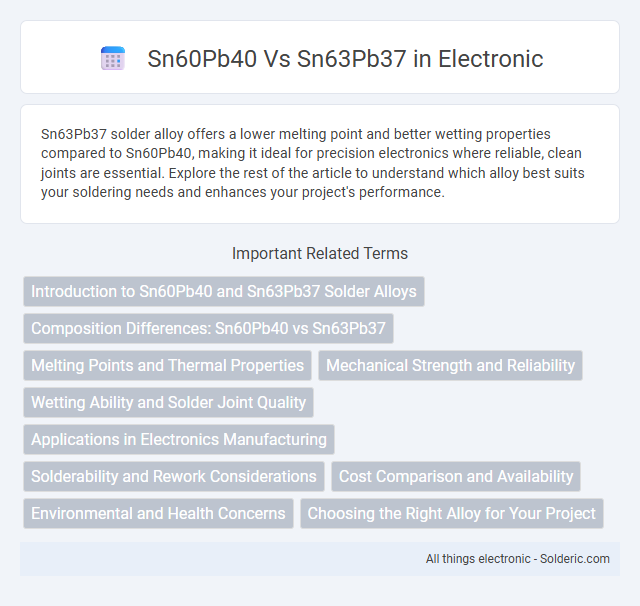Sn63Pb37 solder alloy offers a lower melting point and better wetting properties compared to Sn60Pb40, making it ideal for precision electronics where reliable, clean joints are essential. Explore the rest of the article to understand which alloy best suits your soldering needs and enhances your project's performance.
Comparison Table
| Property | Sn60Pb40 | Sn63Pb37 |
|---|---|---|
| Alloy Composition | 60% Tin (Sn), 40% Lead (Pb) | 63% Tin (Sn), 37% Lead (Pb) |
| Melting Point | 183degC (Partial melting range) | 183degC (Eutectic point) |
| Type | Non-eutectic alloy | Eutectic alloy |
| Melting Behavior | Has pasty range (solid + liquid coexist) | Melts sharply at eutectic temperature |
| Application | Used in soldering requiring gradual melting | Widely used for electronic soldering with fast melting |
| Mechanical Properties | Higher mechanical strength | Better wetting and flow characteristics |
| Cooling Rate | Slower solidification | Faster solidification |
| Toxicity | Contains Lead (Pb), toxic | Contains Lead (Pb), toxic |
Introduction to Sn60Pb40 and Sn63Pb37 Solder Alloys
Sn60Pb40 and Sn63Pb37 are widely used solder alloys in electronics manufacturing, composed of tin (Sn) and lead (Pb) in different ratios. Sn60Pb40 contains 60% tin and 40% lead, offering a melting point around 183degC, while Sn63Pb37, with 63% tin and 37% lead, is a eutectic alloy that melts sharply at 183degC. The eutectic nature of Sn63Pb37 provides better joint reliability and smoother soldering compared to the near-eutectic Sn60Pb40 alloy.
Composition Differences: Sn60Pb40 vs Sn63Pb37
Sn60Pb40 alloy contains 60% tin and 40% lead, resulting in a higher melting point of approximately 183degC, which is suitable for traditional soldering applications. Sn63Pb37 consists of 63% tin and 37% lead, forming a eutectic mixture that melts sharply at 183degC, offering superior flow and wetting properties. The increased tin content in Sn63Pb37 enhances mechanical strength and reduces brittleness compared to Sn60Pb40.
Melting Points and Thermal Properties
Sn63Pb37 solder alloy has a lower melting point of 183degC compared to Sn60Pb40, which melts between 183degC and 190degC due to its higher tin content. The eutectic composition in Sn63Pb37 ensures a sharp melting point, providing consistent thermal performance during soldering. Your applications will benefit from Sn63Pb37's predictable solidification behavior, while Sn60Pb40 offers a wider melting range, affecting heat transfer and joint reliability.
Mechanical Strength and Reliability
Sn60Pb40 solder alloy offers higher mechanical strength due to its elevated lead content, which enhances fatigue resistance in electronic assemblies. Sn63Pb37 is renowned for its superior reliability, providing a more consistent melting point and better wettability, resulting in stable mechanical connections under thermal cycling. The choice between Sn60Pb40 and Sn63Pb37 depends on balancing mechanical durability with long-term joint integrity in specific applications.
Wetting Ability and Solder Joint Quality
Sn63Pb37 solder alloy exhibits superior wetting ability compared to Sn60Pb40 due to its eutectic composition, promoting faster melting and better flow on metal surfaces. This enhanced wetting leads to higher-quality solder joints with improved mechanical strength and reduced porosity. Choosing Sn63Pb37 can result in more reliable and consistent solder connections for Your electronic assemblies.
Applications in Electronics Manufacturing
Sn63Pb37 solder alloy is widely preferred in electronics manufacturing due to its eutectic composition, which provides a sharp melting point at 183degC, ensuring reliable and consistent solder joints for printed circuit boards (PCBs). Sn60Pb40, with its slightly higher melting range (183-190degC), is often used in applications requiring improved mechanical strength and thermal fatigue resistance, such as through-hole component soldering and repair work. Your choice between Sn60Pb40 and Sn63Pb37 depends on specific manufacturing needs, balancing melting characteristics with joint reliability for optimal electronics assembly.
Solderability and Rework Considerations
Sn63Pb37 offers superior solderability due to its eutectic composition, providing a lower melting point of 183degC compared to the 190-227degC range of Sn60Pb40, which simplifies the soldering process and improves wetting. Sn63Pb37's sharp melting point minimizes the risk of cold solder joints and enhances rework efficiency, while Sn60Pb40's non-eutectic nature causes a mushy melting range that complicates rework and can lead to higher thermal stress on components. For applications requiring reliable solder joints and easier rework, Sn63Pb37 is generally preferred over Sn60Pb40.
Cost Comparison and Availability
Sn60Pb40 solder is generally more cost-effective and widely available due to its simpler alloy composition and longer market presence. Sn63Pb37 solder, known for its eutectic properties and superior joint quality, can be slightly more expensive and sometimes harder to source in bulk. Your choice depends on balancing budget constraints with specific performance requirements, especially when prioritizing availability and cost.
Environmental and Health Concerns
Sn60Pb40 solder contains a higher lead content than Sn63Pb37, posing more significant environmental and health risks due to lead's toxicity and bioaccumulation potential. Sn63Pb37, with its balanced eutectic composition, not only offers better mechanical properties but also slightly reduces lead exposure in soldering processes. You should consider using Sn63Pb37 for safer handling and to minimize environmental contamination in electronics manufacturing.
Choosing the Right Alloy for Your Project
Selecting between Sn60Pb40 and Sn63Pb37 alloys depends on your project's soldering requirements and reliability standards. Sn63Pb37 offers a eutectic composition with a sharp melting point of 183degC, ensuring faster solidification and reduced thermal stress, ideal for precision electronics. Sn60Pb40 melts over a range of 183-190degC, providing better mechanical strength but slower cooling, which may suit applications needing enhanced durability.
Sn60Pb40 vs Sn63Pb37 Infographic

 solderic.com
solderic.com